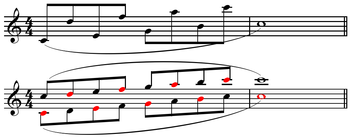Blind octave
Appearance

In music, a blind octave is the alternate doubling above and below a successive scale or trill notes: "the passage being played...alternately in the higher and lower octave."[1] According to Grove's Dictionary of Music and Musicians, the device is not to be introduced into the works of "older composers" (presumably those preceding Liszt).[2]

Alternately, a blind octave may occur "in a rapid octave passage when one note of each alternate octave is omitted."[3] The effect is to simulate octave doubling using a solo instrument.
References
[edit]- ^ Apel, Willi (1969). Harvard Dictionary of Music, p.97. ISBN 978-0-674-37501-7.
- ^ Sir George Grove, ed. (1910). Grove's Dictionary of Music and Musicians, Volume 3, p.735. The Macmillan Company.
- ^ (June 1, 1907). The Musical Herald, Issues 706-717, p.188. J. Curwen & Sons.

